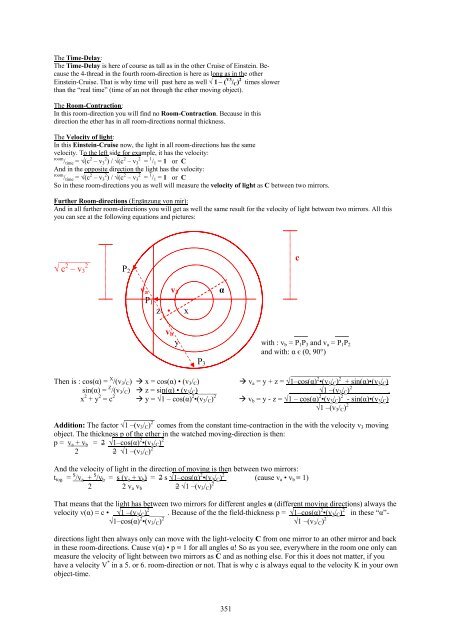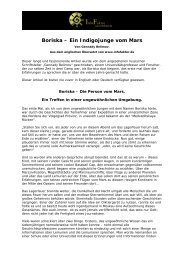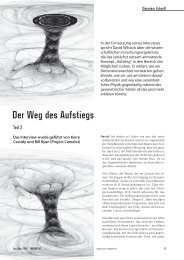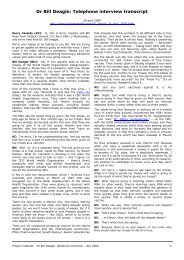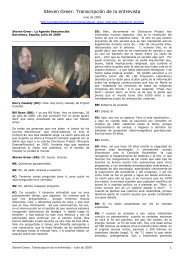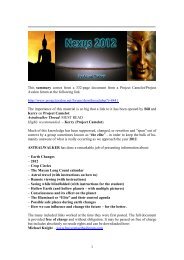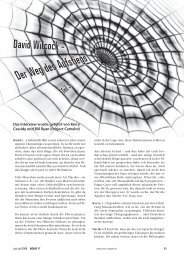- Seite 1 und 2:
The 'New Berlin' base: Nazis in the
- Seite 3 und 4:
was being kept “somewhere in the
- Seite 5 und 6:
A glance at the text The book is al
- Seite 8 und 9:
Base „New Berlin“ - Ein Erlebni
- Seite 10 und 11:
Inhaltsverzeichnis: Vorwort 1 Warum
- Seite 12 und 13:
Autos muss man mit Ästen bewerfen
- Seite 14 und 15:
Der Glorius und der schöne Schwan
- Seite 16 und 17:
Der junge blonde Mann auf dem OP-Ti
- Seite 18 und 19:
In einen Kreis gehen immer genau 7
- Seite 20 und 21:
efand. Diese weitere Alienbasis, ha
- Seite 22 und 23:
marschieren und sich dabei total en
- Seite 24 und 25:
Walter als Synonyme für das Wort U
- Seite 26 und 27:
antut, will ihnen ganz bewusst dami
- Seite 28 und 29:
in unserer Basis gesehen habe, um n
- Seite 30 und 31:
größeren Binnensees befand. In Pa
- Seite 32 und 33:
Picture 0,1: Unsere Basis zusammen
- Seite 34 und 35:
sich über limitierende Geschwindig
- Seite 36 und 37:
Picture 3,0: Die orange Halbhohlkug
- Seite 38 und 39:
enthielt. So jedenfalls ist man in
- Seite 40 und 41:
Zu Picture 4,1: Auf diesem Bild sie
- Seite 42 und 43:
Picture 138,3: Ein Lemure mit einer
- Seite 44 und 45:
Picture 8,0: Einer der Maschinensch
- Seite 46 und 47:
kleinen Motorflugzeug gesehen. Die
- Seite 48 und 49:
Zu Picture10,3: Eine Maschine in un
- Seite 50 und 51:
dem Bild des grauen Monds an der wa
- Seite 52 und 53:
Picture 13: Zwei Glasscheibenmonito
- Seite 54 und 55:
Picture 15,4: Bild aus einem Traum
- Seite 56 und 57:
andauernde intensive Frustphasen. D
- Seite 58 und 59:
Bild noch einmal genau anschauen. D
- Seite 60 und 61:
geschlagen haben und anschließend
- Seite 62 und 63:
edeckt ist. Das Gerüttel im Raum w
- Seite 64 und 65:
Zu Picture27,0: Auf diesem Bild sie
- Seite 66 und 67:
Picture 27,8: Der braune Innerirdis
- Seite 68 und 69:
Nachdem wir vielleicht 10 bis 20 ga
- Seite 70 und 71:
zurückreisen müsse, dann würde i
- Seite 72 und 73:
Per Flugzeug nach New York Kaum das
- Seite 74 und 75:
Was er dabei so alles von sich gege
- Seite 76 und 77:
Gebt mir meinen Hund! Wo ist mein H
- Seite 78 und 79:
Der andere Film hingegen, den ich a
- Seite 80 und 81:
estimmten Ort zu mir sagen würde u
- Seite 82 und 83:
Und mit Hass kann man schließlich
- Seite 84 und 85:
eure Theorien sind, in dem wir auch
- Seite 86 und 87:
während er auf der Erde blau ist.
- Seite 88 und 89:
denen er sich irgendwo anders aufhi
- Seite 90 und 91:
- 20° jetzt, alles O.K.! (Traum) Z
- Seite 92 und 93:
Alltag in unserer Basis (gesammelte
- Seite 94 und 95:
Eine schwarze “Schallplatte” im
- Seite 96 und 97:
Dieser Traum kam mir irgendwie sehr
- Seite 98 und 99:
deshalb jetzt wieder in die Flasche
- Seite 100 und 101:
Berge zu sehen, unten im Bild zogen
- Seite 102 und 103:
gefährlichen Brausen und Zischen i
- Seite 104 und 105:
Josefson Bonifatzius Dilinger war e
- Seite 106 und 107:
Volleyballnetz gespannt zu sein. Es
- Seite 108 und 109:
Verkehrt herum aufgehängt an einem
- Seite 110 und 111:
In Lichtberg (Traum von 2006) Wiede
- Seite 112 und 113:
Ich bin der Wirt in diesem Haus! (T
- Seite 114 und 115:
Baumstämme unter der Erde (Traum 2
- Seite 116 und 117:
hier alle bunte Brillen. Manchmal k
- Seite 118 und 119:
Alle Macht liegt in der Hand der g
- Seite 120 und 121:
Statements diverser Männer in unse
- Seite 122 und 123:
hier? Die Liebe der Grzimek ist gem
- Seite 124 und 125:
nicht vor übler Mind-Control zurü
- Seite 126 und 127:
nicht mehr!). Wieder widerspricht m
- Seite 128 und 129:
Walter Pfeffer ereilt. Denn wie son
- Seite 130 und 131:
Der Bau: Wie bereits erwähnt habe
- Seite 132 und 133:
Zu Picture 39,2: In diesem Film bef
- Seite 134 und 135:
Außenansichten des Baus? Weiß man
- Seite 136 und 137:
Die Gesteine im Bau: In unseren Fil
- Seite 138 und 139:
Knockers The yellow sand in the Bui
- Seite 140 und 141:
Unser satanisches Filmmaterial Walt
- Seite 142 und 143:
Zu Picture 29,2: Die zwei Wege raus
- Seite 144 und 145:
Mutter irgendwann verschwand nachde
- Seite 146 und 147:
weit dorthin! Lass uns heute lieber
- Seite 148 und 149:
Opfer solch eines Unfalls zu werden
- Seite 150 und 151:
Ein Kind in der Gruppe: „Kann man
- Seite 152 und 153:
Picture 31,1: Ein weiteres großes
- Seite 154 und 155:
Doch diese alte Angewohnheit, alles
- Seite 156 und 157:
Zu Picture 31,9: Wie vom alten Herr
- Seite 158 und 159:
einfach wortlos vorausgegangen war,
- Seite 160 und 161:
Picture 32,8: W.P. beschließt zu H
- Seite 162 und 163:
Walter im „Bordell“: Walter hat
- Seite 164 und 165:
Walter inzwischen schon ziemlich an
- Seite 166 und 167:
Durchgefallen und was nun? In einer
- Seite 168 und 169:
Picture 33: W.P. verteilt Lebensmit
- Seite 170 und 171:
also eine Art Trennwand, die eine W
- Seite 172 und 173:
Haus ziehen und überall hausieren
- Seite 174 und 175:
Laut vor Schmerz schluchzend stöß
- Seite 176 und 177:
Monda: „Walter, lass doch mal die
- Seite 178 und 179:
Fahrgästen im Bus laut losheulen.
- Seite 180 und 181:
um seine Ausbildung zum göttlichen
- Seite 182 und 183:
mitkommen wollte, zog Monda alleine
- Seite 184 und 185:
Doch zu ihrem Entsetzen mussten sie
- Seite 186 und 187:
haben. Gestern waren war wir noch h
- Seite 188 und 189:
öffentlich war. In einer Ecke des
- Seite 190 und 191:
Maschinenhalle vorgeworfen, für de
- Seite 192 und 193:
nur ein paar Tränen. Der Klang sei
- Seite 194 und 195:
Picture 36,6: Walter irrt die Schie
- Seite 196 und 197:
zu. Während sie auf diese Hausruin
- Seite 198 und 199:
unter dem Tunnel viel. Beim Aufschl
- Seite 200 und 201:
Gedanken sich nur so ähnlich anhö
- Seite 202 und 203:
Maschinen gehen müsse. „Versuche
- Seite 204 und 205:
Picture184,4: Die gelbe Frau und de
- Seite 206 und 207:
gesamte Bilderfolge sah in etwa so:
- Seite 208 und 209:
einer Lehrkraft ist fast immer ein
- Seite 210 und 211:
Zu Picture132,2: Typisches Schlumpf
- Seite 212 und 213:
Picture134,4: In regelmäßigen Abs
- Seite 214 und 215:
Krone empfangen zu können. Diesmal
- Seite 216 und 217:
im linken orangen Teil des Gehirns,
- Seite 218 und 219:
Wochen und bei Mrs. Grzimek etwa 2-
- Seite 220 und 221:
Picture113,2: Die heilige Kuh in un
- Seite 222 und 223:
Figuren, die immer wieder mal in Fi
- Seite 224 und 225:
Charactereigenschaften zugewiesen u
- Seite 226 und 227:
Im Film habe ich zum Herrn der Schm
- Seite 228 und 229:
Picture100,1: Der Herr der Schmiere
- Seite 230 und 231:
Picture 84: Wieder ein braunes Män
- Seite 232 und 233:
auf dem Rücken liegen. Später dan
- Seite 234 und 235:
drin ist. Das scheint soweit in Ord
- Seite 236 und 237:
Davon ist man dann natürlich auch
- Seite 238 und 239:
Vor etwa ….? kamen wir aus dem…
- Seite 240 und 241:
zuckt sie einen Augenblick lang etw
- Seite 242 und 243:
anwenden muss. Je mehr die fremden
- Seite 244 und 245:
Ich: „Ich weiß auf manchen Bilde
- Seite 246 und 247:
Im Anschluss daran sehe ich in mein
- Seite 248 und 249:
Kaum hatte ich per Zug unser unteri
- Seite 250 und 251:
ansprechbar. Bei gelegentlichen kur
- Seite 252 und 253:
Ich: „Jetzt hört doch endlich ma
- Seite 254 und 255:
so als hätten sie längst gemerkt,
- Seite 256 und 257:
Feuerball in die Luft und ist sofor
- Seite 258 und 259:
den stampfenden Schritten eines Lem
- Seite 260 und 261:
mein Bruder Magba damals auch dazu
- Seite 262 und 263:
macht? Richtig, er testet erst einm
- Seite 264 und 265:
einer Straßenkreuzung mit Wahlzett
- Seite 266 und 267:
Picture 43,4: Die Person mit dem Mi
- Seite 268 und 269:
Hurra, ich bin der Gewinner! Der Dr
- Seite 270 und 271:
Nach dieser Aktion an unserer Masch
- Seite 272 und 273:
irgendwelche Verbrechen die er bega
- Seite 274 und 275:
Picture45,5: Der unterirdische Stei
- Seite 276 und 277:
Anschließend hat sie mir glaube ic
- Seite 278 und 279:
Nachdem ich dann etwa 5 Wochen in d
- Seite 280 und 281:
Hakima: “Up there in the sky live
- Seite 282 und 283:
Nachdem auch Walter und Erydie endl
- Seite 284 und 285:
Picture 47,7: Die Anstecker die die
- Seite 286 und 287:
Unterwelt, die uns in tristen Momen
- Seite 288 und 289:
Meine Lieblingsfarbe ist „Schwein
- Seite 290 und 291:
die ganze Zeit als erster neben der
- Seite 292 und 293:
Danach eine freundliche Männerstim
- Seite 294 und 295:
Mrs. Grzimek: „Wir gehen hier so
- Seite 296 und 297:
eligiös. Eine eindeutige Zuordnung
- Seite 298 und 299:
mir zuvor geraten hatte, mich über
- Seite 300 und 301:
Picture 44,3: Das blaues Fnord an d
- Seite 302 und 303:
Das unsichtbare Karussell in der Lu
- Seite 304 und 305:
Ein Knochenskelett eines Innerirdis
- Seite 306 und 307:
Aber nicht nur der Teufelsgott Visn
- Seite 308 und 309:
langsam Angst in mir aufsteigen, w
- Seite 310 und 311:
der gerade an seinem Schreibtisch s
- Seite 312 und 313:
Der rote Tank In Zusammenhang mit d
- Seite 314 und 315:
Picture 115,6: Ein graues Männchen
- Seite 316 und 317:
Picture 186: Die grauen Pyramiden i
- Seite 318 und 319: Picture 187: Eine flächentreue Kar
- Seite 320 und 321: Eine Weile schauen wir uns noch ers
- Seite 322 und 323: ihren Leib werden sie dabei ständi
- Seite 324 und 325: jedoch erneut wieder ohnmächtig. A
- Seite 326 und 327: Mann auf der Liege ab. Während ich
- Seite 328 und 329: Leblose Leiber am Grund eines stein
- Seite 330 und 331: Ernst zu mir herüber so als wolle
- Seite 332 und 333: Der andere Uniformierte rechts nebe
- Seite 334 und 335: ist du! Klipp-Klapp, Klipp-Klapp,
- Seite 336 und 337: Tod neben dem Zug In diesem Film tr
- Seite 338 und 339: Glaswand selbst. Schon in einer Hö
- Seite 340 und 341: Und natürlich sind auch Arschloch
- Seite 342 und 343: Also nur weil die von den Außerird
- Seite 344 und 345: spät abends ein stattliches Eis f
- Seite 346 und 347: Die hat mir der Teufel beigebracht.
- Seite 348 und 349: Aus den roten Möhren im Boden wäc
- Seite 350 und 351: solange bis ich wieder dort bin wo
- Seite 352 und 353: Bist du der weiße Prinz der Unterw
- Seite 354 und 355: Bergsee in den Bergen irgendwan so
- Seite 356 und 357: Ein wirklich ungewöhnlicher Traum
- Seite 358 und 359: nicht wundern, wenn noch mal mein
- Seite 360 und 361: zwecks Geheimhaltung dieses heiklen
- Seite 362 und 363: Welchen Halt hat noch eine Gesellsc
- Seite 364 und 365: Anhang mit unseren physikalischen T
- Seite 366 und 367: Noch während sich die ineinander v
- Seite 370 und 371: Further Consequences of their Room-
- Seite 372 und 373: In order to derive these Photon-equ
- Seite 374 und 375: Big-Bang in the Universe but only o
- Seite 376 und 377: That this equation must be correct
- Seite 378 und 379: K = √GM √R 3 That means that t
- Seite 380 und 381: Im Kapitel „Their gravitational i
- Seite 382 und 383: Bemerkung (von mir): Dass man trotz
- Seite 384 und 385: Ihre elektrische Kraft (Film): Selb
- Seite 386 und 387: Folgende Bilder stammen ebenfalls a
- Seite 388 und 389: Während man den Kindern dort im Fi
- Seite 390 und 391: Δ(1950) (4X + 7 /2) • 3 X • 3
- Seite 392 und 393: DSJ DS1 DSJ DSJ +- (2460) (4X + 5)
- Seite 394 und 395: Woher kommen diese Zahlen 3 / 2 ; 5
- Seite 396 und 397: Folgerungen aus diesen Wechselwirku
- Seite 398 und 399: Möglichkeit a) könnte man im obig
- Seite 400 und 401: Insgesamt ergeben sich also für da
- Seite 402 und 403: Und warum könnte das Elektron eine
- Seite 404 und 405: späterer Implusion dieser Räume e
- Seite 406 und 407: Aussehen der Geistgirlande einer Pe
- Seite 408 und 409: grünen Geist-Drillköpfe aus der r
- Seite 410 und 411: Can one look into future / pasture?


